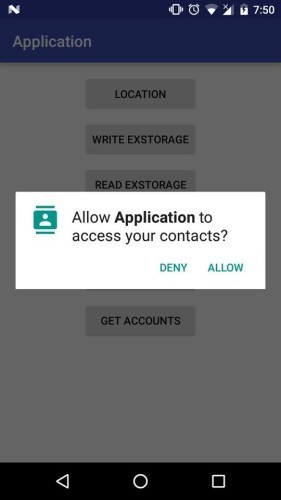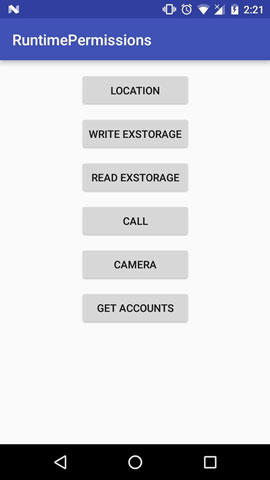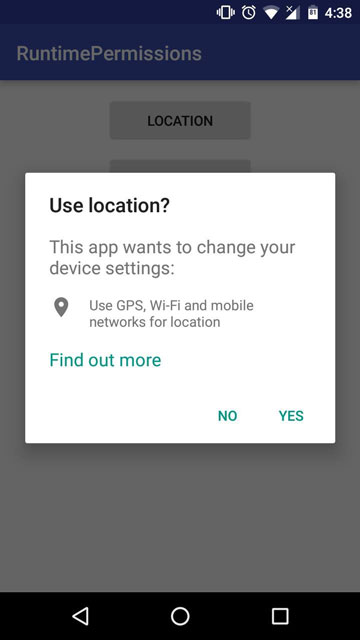Request multiple permissions android
request multiple permissions android react native
Starting from Android Marshmallow (API 23), users will be asked for permissions while the app is running. This way, a user is able to choose which permissions they should grant without affecting the application flow. In this tutorial I will cover requesting runtime permissions in Android M and N, how to perform a request, get its result and then handle it.android request permission at runtime example

There are many user-permissions in Android but I am only going to focus on some of the most used.
You can find the code for this project in github.
To begin, create a new project in Android Studio, choosing a minimum API level of 23 and adding an Empty Activity. This will be the only activity in the project.
Declaring Permissions
Open AndroidManifest.xml and add the following permissions:<uses-permission android:name="android.permission.ACCESS_COARSE_LOCATION"/> <uses-permission android:name="android.permission.ACCESS_FINE_LOCATION"/> <uses-permission android:name="android.permission.CALL_PHONE"/> <uses-permission android:name="android.permission.WRITE_EXTERNAL_STORAGE"/> <uses-permission android:name="android.permission.READ_EXTERNAL_STORAGE"/> <uses-permission android:name="android.permission.CAMERA"/> <uses-permission android:name="android.permission.GET_ACCOUNTS"/>
The permissions above are some of the most used in android apps, but all of them work in a similar way.
Asking for Permission
Each of this permissions will be asked for by using a button. Update the code inside activity_main.xml to:<?xml version="1.0" encoding="utf-8"?> <RelativeLayout xmlns:android="http://schemas.android.com/apk/res/android" xmlns:tools="http://schemas.android.com/tools" android:layout_width="match_parent" android:layout_height="match_parent" android:paddingBottom="@dimen/activity_vertical_margin" android:paddingLeft="@dimen/activity_horizontal_margin" android:paddingRight="@dimen/activity_horizontal_margin" android:paddingTop="@dimen/activity_vertical_margin" tools:context="com.example.theodhor.runtimepermissions.MainActivity"> <LinearLayout android:orientation="vertical" android:layout_width="wrap_content" android:layout_height="wrap_content" android:layout_centerHorizontal="true"> <Button android:layout_width="match_parent" android:layout_height="wrap_content" android:text="Location" android:id="@+id/location" android:layout_marginBottom="10dp" android:onClick="ask" /> <Button style="?android:attr/buttonStyleSmall" android:layout_width="match_parent" android:layout_height="wrap_content" android:text="Write ExStorage" android:id="@+id/write" android:onClick="ask" android:layout_marginBottom="10dp" /> <Button android:layout_width="match_parent" android:layout_height="wrap_content" android:text="Read ExStorage" android:id="@+id/read" android:layout_marginBottom="10dp" android:onClick="ask" /> <Button android:layout_width="match_parent" android:layout_height="wrap_content" android:text="Call" android:id="@+id/call" android:layout_marginBottom="10dp" android:onClick="ask" /> <Button android:layout_width="match_parent" android:layout_height="wrap_content" android:text="Camera" android:id="@+id/camera" android:layout_marginBottom="10dp" android:onClick="ask" /> <Button android:layout_width="match_parent" android:layout_height="wrap_content" android:text="Get Accounts" android:id="@+id/accounts" android:layout_marginBottom="10dp" android:onClick="ask" /> </LinearLayout> </RelativeLayout>
This is the layout you just created:

At this stage, if a user installed the application, it would require the following permissions:

Inside MainActivity.java, after onCreate add this method:private void askForPermission(String permission, Integer requestCode) { if (ContextCompat.checkSelfPermission(MainActivity.this, permission) != PackageManager.PERMISSION_GRANTED) { // Should we show an explanation? if (ActivityCompat.shouldShowRequestPermissionRationale(MainActivity.this, permission)) { //This is called if user has denied the permission before //In this case I am just asking the permission again ActivityCompat.requestPermissions(MainActivity.this, new String[]{permission}, requestCode); } else { ActivityCompat.requestPermissions(MainActivity.this, new String[]{permission}, requestCode); } } else { Toast.makeText(this, "" + permission + " is already granted.", Toast.LENGTH_SHORT).show(); } }
This method asks a user for permissions. Firstly it checks whether the permission you are asking for is granted or not. If it is, then the app shows a Toast saying that the permission was already granted. If the permission is not granted, it checks if the user has denied this permission before. If the permission is important for the app, it should be requested again. If the permission was not denied before, perform a request by calling ActivityCompat.requestPermissions(MainActivity.this, new String[]{permission}, requestCode);
Each permission request needs three parameters. The first is context, the second a String array of permission(s), and the third the requestCode of type Integer. The last parameter is a random code attached to the request, and can be any number that suits your use case. When a result returns in the activity, it contains this code and uses it to differentiate multiple results from each other.
The method is ready to perform requests, and now it should be linked with the corresponding buttons. Each of the buttons created has an android:onClick="ask" property.
You need to create a public method called ask that will be called on each click of the buttons. It’s code is:public void ask(View v){ switch (v.getId()){ case R.id.location: askForPermission(Manifest.permission.ACCESS_FINE_LOCATION,LOCATION); break; case R.id.call: askForPermission(Manifest.permission.CALL_PHONE,CALL); break; case R.id.write: askForPermission(Manifest.permission.WRITE_EXTERNAL_STORAGE,WRITE_EXST); break; case R.id.read: askForPermission(Manifest.permission.READ_EXTERNAL_STORAGE,READ_EXST); break; case R.id.camera: askForPermission(Manifest.permission.CAMERA,CAMERA); break; case R.id.accounts: askForPermission(Manifest.permission.GET_ACCOUNTS,ACCOUNTS); break; default: break; } }
The second parameter of the askForPermission method are some random integers. Add their declarations before the onCreate() method:static final Integer LOCATION = 0x1; static final Integer CALL = 0x2; static final Integer WRITE_EXST = 0x3; static final Integer READ_EXST = 0x4; static final Integer CAMERA = 0x5; static final Integer ACCOUNTS = 0x6; static final Integer GPS_SETTINGS = 0x7;
Now the application can perform requests. The next step is handling the request results.
Handling the Results
To handle the results of a permission request, the onRequestPermissionsResult method is called. It’s code is below:@Override public void onRequestPermissionsResult(int requestCode, String[] permissions, int[] grantResults) { super.onRequestPermissionsResult(requestCode, permissions, grantResults); if(ActivityCompat.checkSelfPermission(this, permissions[0]) == PackageManager.PERMISSION_GRANTED){ switch (requestCode) { //Location case 1: askForGPS(); break; //Call case 2: Intent callIntent = new Intent(Intent.ACTION_CALL); callIntent.setData(Uri.parse("tel:" + "{This is a telephone number}")); if (ActivityCompat.checkSelfPermission(this, Manifest.permission.CALL_PHONE) != PackageManager.PERMISSION_GRANTED) { startActivity(callIntent); } break; //Write external Storage case 3: break; //Read External Storage case 4: Intent imageIntent = new Intent(Intent.ACTION_PICK, android.provider.MediaStore.Images.Media.EXTERNAL_CONTENT_URI); startActivityForResult(imageIntent, 11); break; //Camera case 5: Intent takePictureIntent = new Intent(MediaStore.ACTION_IMAGE_CAPTURE); if (takePictureIntent.resolveActivity(getPackageManager()) != null) { startActivityForResult(takePictureIntent, 12); } break; //Accounts case 6: AccountManager manager = (AccountManager) getSystemService(ACCOUNT_SERVICE); Account[] list = manager.getAccounts(); Toast.makeText(this,""+list[0].name,Toast.LENGTH_SHORT).show(); for(int i=0; i<list.length;i++){ Log.e("Account "+i,""+list[i].name); } } Toast.makeText(this, "Permission granted", Toast.LENGTH_SHORT).show(); }else{ Toast.makeText(this, "Permission denied", Toast.LENGTH_SHORT).show(); } }
When a result is returned, it checks whether the permission was granted or not. If it is, the requestCode is passed to a switch statement to differentiate the results. I added extra lines inside each case to show further steps, but they are just examples.
Location Request
At case 1: there is a function called askForGPS(). This function prompts the user to enable GPS if it’s not enabled. If the device is not connected to GPS after the user has granted the location permission, the dialog below is shown:

To show this dialog, you need a GoogleApiClient. First, declare some variables by adding these lines before onCreate:GoogleApiClient client; LocationRequest mLocationRequest; PendingResult<LocationSettingsResult> result;
And build the client inside the onCreate method:client = new GoogleApiClient.Builder(this) .addApi(AppIndex.API) .addApi(LocationServices.API) .build();
Now the client is built, it needs to connected when the app starts and disconnect when it stops. Add these two overriden methods to MainActivity:@Override public void onStart() { super.onStart(); client.connect(); } @Override public void onStop() { super.onStop(); client.disconnect(); }
Finally, add the function that shows the GPS dialog:private void askForGPS(){ mLocationRequest = LocationRequest.create(); mLocationRequest.setPriority(LocationRequest.PRIORITY_HIGH_ACCURACY); mLocationRequest.setInterval(30 * 1000); mLocationRequest.setFastestInterval(5 * 1000); LocationSettingsRequest.Builder builder = new LocationSettingsRequest.Builder().addLocationRequest(mLocationRequest); builder.setAlwaysShow(true); result = LocationServices.SettingsApi.checkLocationSettings(client, builder.build()); result.setResultCallback(new ResultCallback<LocationSettingsResult>() { @Override public void onResult(LocationSettingsResult result) { final Status status = result.getStatus(); switch (status.getStatusCode()) { case LocationSettingsStatusCodes.SUCCESS: break; case LocationSettingsStatusCodes.RESOLUTION_REQUIRED: try { status.startResolutionForResult(MainActivity.this, GPS_SETTINGS); } catch (IntentSender.SendIntentException e) { } break; case LocationSettingsStatusCodes.SETTINGS_CHANGE_UNAVAILABLE: break; } } }); }
Requesting Permissions of Manifest.permission.ACCESS_FINE_LOCATION at Run Time
Refer to last example of "Get my Last Known Location, by calling LocationServices.FusedLocationApi.getLastLocation()" in Android Studio, you will be prompted with "code should explicitly check to see if permission is available (with 'checkPermission') or explicitly handle a potential 'SecurityException'" on the code "LocationServices.FusedLocationApi.getLastLocation(mGoogleApiClient)".

Last example handle 'SecurityException' with try/catch. This example show another approach to check if permission is available with 'checkPermission', then call ActivityCompat.requestPermissions() if need, and handle the user answer in onRequestPermissionsResult().
reference: Android Developers - Requesting Permissions at Run Time

notice for sending location to Android Emulator: I have to open another app, Google Maps, to monitor location, otherwise my example cannot get the updated location.
Edit MainActivity.java from last post.
package com.blogspot.android_er.androidgetlastlocation;
import android.Manifest;
import android.content.pm.PackageManager;
import android.location.Location;
import android.net.Uri;
import android.os.Bundle;
import android.support.annotation.NonNull;
import android.support.annotation.Nullable;
import android.support.v4.app.ActivityCompat;
import android.support.v7.app.AppCompatActivity;
import android.view.View;
import android.widget.Button;
import android.widget.TextView;
import android.widget.Toast;
import com.google.android.gms.common.ConnectionResult;
import com.google.android.gms.common.api.GoogleApiClient;
import com.google.android.gms.location.LocationServices;
public class MainActivity extends AppCompatActivity
implements GoogleApiClient.ConnectionCallbacks,
GoogleApiClient.OnConnectionFailedListener {
Button btnGetLastLocation;
TextView textLastLocation;
GoogleApiClient mGoogleApiClient;
Location mLastLocation;
static final int MY_PERMISSIONS_REQUEST_ACCESS_FINE_LOCATION = 1;
@Override
protected void onCreate(Bundle savedInstanceState) {
super.onCreate(savedInstanceState);
setContentView(R.layout.activity_main);
btnGetLastLocation = (Button) findViewById(R.id.getlastlocation);
btnGetLastLocation.setOnClickListener(btnGetLastLocationOnClickListener);
textLastLocation = (TextView) findViewById(R.id.lastlocation);
// Create an instance of GoogleAPIClient.
if (mGoogleApiClient == null) {
mGoogleApiClient = new GoogleApiClient.Builder(this)
.addConnectionCallbacks(this)
.addOnConnectionFailedListener(this)
.addApi(LocationServices.API)
.build();
}
}
View.OnClickListener btnGetLastLocationOnClickListener = new View.OnClickListener() {
@Override
public void onClick(View v) {
if (mGoogleApiClient != null) {
if (mGoogleApiClient.isConnected()) {
getMyLocation();
} else {
Toast.makeText(MainActivity.this,
"!mGoogleApiClient.isConnected()", Toast.LENGTH_LONG).show();
}
} else {
Toast.makeText(MainActivity.this,
"mGoogleApiClient == null", Toast.LENGTH_LONG).show();
}
}
};
/*
// Handle 'SecurityException' with try/catch
private void getMyLocation(){
try{
//code should explicitly check to see if permission is available
//(with 'checkPermission') or explicitly handle a potential 'SecurityException'
//
mLastLocation = LocationServices.FusedLocationApi.getLastLocation(mGoogleApiClient);
if (mLastLocation != null) {
textLastLocation.setText(
String.valueOf(mLastLocation.getLatitude()) + "\n"
+ String.valueOf(mLastLocation.getLongitude()));
Toast.makeText(MainActivity.this,
String.valueOf(mLastLocation.getLatitude()) + "\n"
+ String.valueOf(mLastLocation.getLongitude()),
Toast.LENGTH_LONG).show();
}else{
Toast.makeText(MainActivity.this,
"mLastLocation == null",
Toast.LENGTH_LONG).show();
}
} catch (SecurityException e){
Toast.makeText(MainActivity.this,
"SecurityException:\n" + e.toString(),
Toast.LENGTH_LONG).show();
}
}
*/
//------------------------------------------------------------------------------
//ref: Requesting Permissions at Run Time
//http://developer.android.com/training/permissions/requesting.html
//------------------------------------------------------------------------------
private void getMyLocation() {
if (ActivityCompat.checkSelfPermission(this, Manifest.permission.ACCESS_FINE_LOCATION)
!= PackageManager.PERMISSION_GRANTED
&& ActivityCompat.checkSelfPermission(this, Manifest.permission.ACCESS_COARSE_LOCATION)
!= PackageManager.PERMISSION_GRANTED) {
// TODO: Consider calling
// ActivityCompat#requestPermissions
// here to request the missing permissions, and then overriding
// public void onRequestPermissionsResult(int requestCode, String[] permissions,
// int[] grantResults)
// to handle the case where the user grants the permission. See the documentation
// for ActivityCompat#requestPermissions for more details.
//------------------------------------------------------------------------------
ActivityCompat.requestPermissions(MainActivity.this,
new String[]{Manifest.permission.ACCESS_FINE_LOCATION},
MY_PERMISSIONS_REQUEST_ACCESS_FINE_LOCATION);
return;
}
mLastLocation = LocationServices.FusedLocationApi.getLastLocation(mGoogleApiClient);
if (mLastLocation != null) {
textLastLocation.setText(
String.valueOf(mLastLocation.getLatitude()) + "\n"
+ String.valueOf(mLastLocation.getLongitude()));
Toast.makeText(MainActivity.this,
String.valueOf(mLastLocation.getLatitude()) + "\n"
+ String.valueOf(mLastLocation.getLongitude()),
Toast.LENGTH_LONG).show();
}else{
Toast.makeText(MainActivity.this,
"mLastLocation == null",
Toast.LENGTH_LONG).show();
}
}
@Override
public void onRequestPermissionsResult(
int requestCode, @NonNull String[] permissions, @NonNull int[] grantResults) {
switch (requestCode) {
case MY_PERMISSIONS_REQUEST_ACCESS_FINE_LOCATION: {
// If request is cancelled, the result arrays are empty.
if (grantResults.length > 0
&& grantResults[0] == PackageManager.PERMISSION_GRANTED) {
Toast.makeText(MainActivity.this,
"permission was granted, :)",
Toast.LENGTH_LONG).show();
getMyLocation();
} else {
Toast.makeText(MainActivity.this,
"permission denied, ...:(",
Toast.LENGTH_LONG).show();
}
return;
}
// other 'case' lines to check for other
// permissions this app might request
}
}
@Override
protected void onStart() {
mGoogleApiClient.connect();
super.onStart();
}
@Override
protected void onStop() {
mGoogleApiClient.disconnect();
super.onStop();
}
@Override
public void onConnected(@Nullable Bundle bundle) {
getMyLocation();
}
@Override
public void onConnectionSuspended(int i) {
Toast.makeText(MainActivity.this,
"onConnectionSuspended: " + String.valueOf(i),
Toast.LENGTH_LONG).show();
}
@Override
public void onConnectionFailed(@NonNull ConnectionResult connectionResult) {
Toast.makeText(MainActivity.this,
"onConnectionFailed: \n" + connectionResult.toString(),
Toast.LENGTH_LONG).show();
}
}
Related:
- Request Location Updates with LocationListener.onLocationChanged()


.jpeg)


.jpeg)







.jpeg)

No comments:
Post a Comment